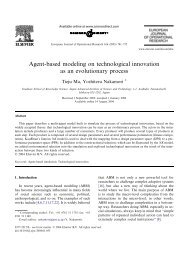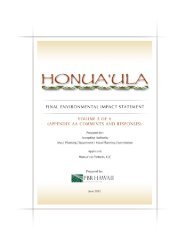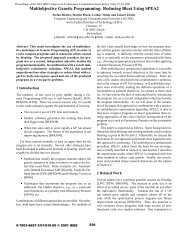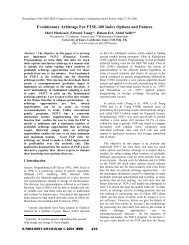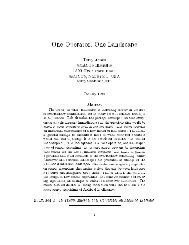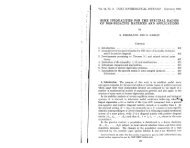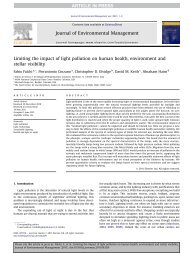draft eis comments and responses - Lee Altenberg
draft eis comments and responses - Lee Altenberg
draft eis comments and responses - Lee Altenberg
You also want an ePaper? Increase the reach of your titles
YUMPU automatically turns print PDFs into web optimized ePapers that Google loves.
Kamana‘o Crabbe<br />
SUBJECT: HONUAÿULA DRAFT ENVIRONMENTAL IMPACT STATEMENT AND PROJECT<br />
DISTRICT PHASE II APPLICATION<br />
May 31, 2012<br />
Page 3 of 6<br />
<strong>and</strong> requested revisions, including: 1) editorial changes; 2) that the total number of survey manhours<br />
<strong>and</strong> the spacing of survey transects be noted; <strong>and</strong> 3) a large plan map of the survey area<br />
with sites <strong>and</strong> features plotted be included. In addition, the SHPD letter states: “This report<br />
presents a comprehensive summary of past archaeological work in this area <strong>and</strong> nicely<br />
incorporates previous surveys in the discussion of current findings.” The September 8, 2010 SHPD<br />
letter is attached for your review <strong>and</strong> records.<br />
In response to SHPD’s September 8, 2010 letter commenting on the archaeological inventory<br />
survey, archaeologist Aki Sinoto has: 1) revised the archaeological inventory survey to address<br />
SHPD’s concerns; <strong>and</strong> 2) submitted the revised archaeological inventory survey to SHPD in April<br />
2011.<br />
In July <strong>and</strong> August of 2011, Daniel Kanahele of Maui Cultural L<strong>and</strong>s submitted letters to<br />
Honua‘ula Partners, LLC’s representative Charlie Jencks <strong>and</strong> SHPD providing additional<br />
<strong>comments</strong> on the archaeological inventory survey (dated March 2010) that was included in the<br />
Draft EIS. Honua‘ula Partners, LLC’s representative Charlie Jencks, consultant archaeologist Aki<br />
Sinoto, <strong>and</strong> consultant cultural advisor Kimokeo Kapahulehua responded to these letters in<br />
writing. In the summer of 2011 Maui Cultural L<strong>and</strong>s members also made a presentation to SHPD<br />
regarding their inspections of the Property.<br />
In response to the concerns Maui Cultural L<strong>and</strong>s members expressed to SHPD in the summer of<br />
2011, on September 23, 2011 archaeologist Aki Sinoto <strong>and</strong> cultural advisor Kimokeo<br />
Kapahulehua met with SHPD archaeologist Morgan Davis <strong>and</strong> SHPD cultural historian Hinano<br />
Rodrigues at SHPD’s Maui office. Subsequently, as recommended by SHPD, Honua‘ula Partners,<br />
LLC’s representative Charlie Jencks, consultant archaeologist Aki Sinoto, <strong>and</strong> consultant cultural<br />
advisor Kimokeo Kapahulehua met with members of Maui Cultural L<strong>and</strong>s <strong>and</strong> other community<br />
members at Maui Community College on November 17, 2011. Maui Cultural L<strong>and</strong>s members <strong>and</strong><br />
other community members present at the November 17, 2011 meeting included: Daniel<br />
Kanahele, Janet Six, ÿEkolu Lindsey, Lucienne de Naie, Jocelyn Costa, <strong>and</strong> Clifford Ornellas.<br />
Others present at the meeting included Stanley Solamillo, a cultural resource planner with the<br />
Maui Planning Department, <strong>and</strong> Tanya <strong>Lee</strong> Greig, the director of Cultural Surveys Hawaii’s Maui<br />
office.<br />
As a result of the November 17, 2011 meeting, the archaeological inventory survey report was<br />
further revised to: 1) recommend preservation of a section of a post-contact agricultural wall<br />
documented in the archaeological inventory survey but not previously recommended for<br />
preservation; 2) add descriptive narrative information for two post-contact agricultural walls; <strong>and</strong><br />
3) revise pertinent map figures in the report. Archaeologist Aki Sinoto submitted the further<br />
revised archaeological inventory survey report to SHPD in March 2012. Since the SHPD Maui<br />
archaeologist had recently resigned, copies of the revised archaeological inventory survey report<br />
were transmitted to SHPD’s main office in Kapolei <strong>and</strong> to Dr. Theresa Donham, the interim SHPD<br />
chief of archaeology in Hilo. In April 2012, Dr. Donham notified archaeologist Aki Sinoto that<br />
the report was forwarded to the SHPD Maui office for review due to the hiring of replacement<br />
personnel. As of May 2012, SHPD has not completed its review of the revised (March 2012)<br />
archaeological inventory survey.<br />
Kamana‘o Crabbe<br />
SUBJECT: HONUAÿULA DRAFT ENVIRONMENTAL IMPACT STATEMENT AND PROJECT<br />
DISTRICT PHASE II APPLICATION<br />
May 31, 2012<br />
Page 4 of 6<br />
In your letter it is stated that the “revelation” regarding the 13 additional archaeological sites:<br />
…precludes OHA from issuing a bona fide approval for the CRPP, among other things, since<br />
the Revised Archaeological Inventory Survey (Revised AIS) appears inaccurate. Moreover,<br />
the matter of SHPD’s review of the Revised AIS is not yet finalized. Thus, it would be<br />
imprudent <strong>and</strong> premature of OHA to endorse either the Draft EIS or CRPP considering that<br />
SHPD’s review of the Revised AIS is in fact still pending (<strong>and</strong> with inclusion of additional<br />
sites needing official documentation). In short, these issues are not yet ripe for approval.<br />
(page 4)<br />
In light of:<br />
1. SHPD’s August, 26, 2010 site visit <strong>and</strong> subsequent conclusion that no significant<br />
unrecorded sites were noted at that time (i.e. during the August, 26, 2010 site visit);<br />
2. SHPD’s review of the archaeological inventory survey <strong>and</strong> requested revisions; <strong>and</strong><br />
3. The fact that the archaeological inventory survey has been revised to address SHPD’s<br />
concerns <strong>and</strong> has been submitted to SHPD for final approval;<br />
We hope that OHA can now consider the CRPP “ripe” for review <strong>and</strong> approval. Honuaÿula<br />
Partners, LLC’s representative, archaeologist, <strong>and</strong> cultural advisor would be pleased to assist OHA<br />
with its review <strong>and</strong> approval of the CRPP by answering any questions OHA may have or<br />
providing additional information OHA may request.<br />
Other Issues & Concerns<br />
We note that other issues of concern to OHA relate in some ways to the revised archaeological<br />
inventory survey <strong>and</strong> the information provided to OHA regarding 13 additional archaeological<br />
sites in the northern portion of Honua‘ula not included in the archaeological inventory survey.<br />
With SHPD’s site visit <strong>and</strong> September 8, 2010 letter, we hope that OHA’s major concerns have<br />
been resolved.<br />
Regarding your concern about educating golfers about the significance of archaeological/cultural<br />
sites, we agree that it is imperative to educate golfers on proper protocol in this regard. The<br />
Honuaÿula Golf Course Best Management Practices (BMPs), included as Appendix C in the Draft<br />
EIS to which you refer, were prepared to ensure that Honuaÿula’s golf course is developed <strong>and</strong><br />
operated in an environmentally responsible manner so that potential impacts are mitigated.<br />
Although the primary goals of the BMPs are to reduce the turf chemical <strong>and</strong> water required to<br />
manage the golf course <strong>and</strong> minimize waste generation, the BMPs also include recommendations<br />
for golfer education. In particular is it recommended that the golf course superintendent produce<br />
literature to inform golfers of the specifics of the golf course <strong>and</strong> encourage responsible behavior.<br />
Information on the significance of archaeological/cultural sites could easily be incorporated into<br />
this literature. Because Honuaÿula’s golf course is intended to be a homeowner’s course, the<br />
course will not have a significant amount of general public golfers that are unfamiliar with the<br />
course. Thus, homeowner golfers can be educated regarding the significance of<br />
archaeological/cultural sites <strong>and</strong> would hopefully retain this information <strong>and</strong> develop an<br />
awareness of the unique aspects of the golf course. With familiarity of the course it can also be<br />
expected that homeowner golfers will know where restroom facilities are in relation to golf course<br />
holes <strong>and</strong> thereby <strong>and</strong> can anticipate the need to relive themselves in advance <strong>and</strong> can plan<br />
accordingly.



